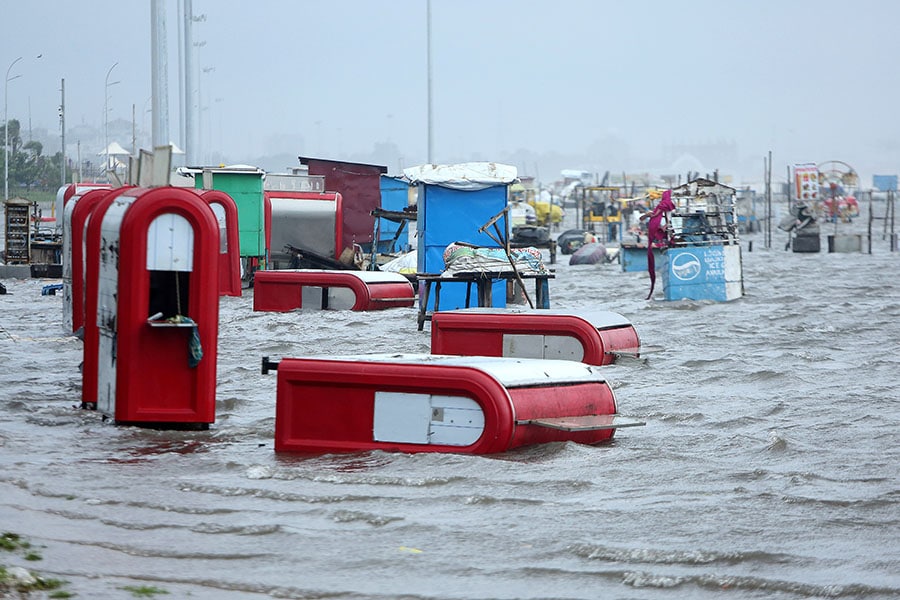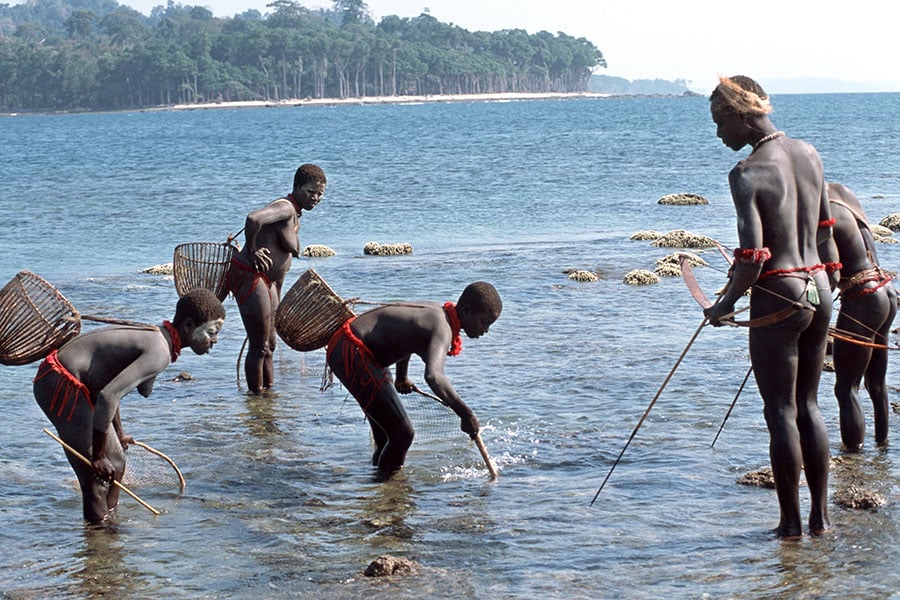
On the way to climate hell: Will COP27 negotiations enforce climate action commitments?
By Sumaira Abdulali| Nov 15, 2022
The debate of economic growth versus environment is central to our times and at the heart of the climate negotiations of COP27. Escalating climate events worldwide show that we are living on borrowed time
 [CAPTION]The beautiful coastal resort of Sharm-el-Shaikh, famous for its coral reef and rainbow fish, where CoP27 is currently being held.
Image: Shutterstock[/CAPTION]
[CAPTION]The beautiful coastal resort of Sharm-el-Shaikh, famous for its coral reef and rainbow fish, where CoP27 is currently being held.
Image: Shutterstock[/CAPTION]
On October 28, ecological economist Herman Daly, a leading proponent of ‘sustainable development’ rather than ‘sustainable growth’ for over 50 years, passed away. According to Daly, sustainable development took into account the cost of pollution and environmental harm caused by economic growth, while sustainable growth did not.
Ten days after his death, on November 7, delegates to the 27th Conference of Parties (COP27) of the United Nations Framework for Climate Change (UNFCC) flew into the beautiful coastal resort of Sharm el-Sheikh, Egypt—famous for its coral reefs—in hundreds of polluting private jets. COP27 marks 30 years since the UNFCC was formed to protect us from the worst effects of climate change, brought about by pollution and environmental harm from breakneck economic growth.
_RSS_Abel Fattah El-Sisi, president of COP27, says on the CoP27 website: “We are now able to better understand the science behind climate change, better assess its impacts, and better develop tools to address its causes and consequences.”
However, in an impassioned opening speech, UN Secretary-General Antonio Guterres felt understanding the problem alone would be inadequate. “These UN conferences are a reminder that the answer is in our hands and the clock is ticking as we are in the fight of our lives. And we are losing.”
Guterres’s speech was made in the backdrop of escalating climate events worldwide, including floods, droughts, wildfires across continents—from the US to Australia and India. Nevertheless, just 26 of 193 countries that agreed a year ago at COP26 to step up their climate actions have followed through with more ambitious plans to meet the ever-more urgent goals of slowing the world’s climate crisis.
Climate negotiations between China and the US have stalled for the last year amidst their deteriorating political relationship. The war in Ukraine takes precedence over climate change as other urgent issues like shortages of Russian gas for electricity, forced migration in the European Union and worldwide food shortages dominate.
Acknowledging the problems caused by the war, Guterres explains, in his speech: “But we cannot, we cannot accept that our attention is not focussed on climate change… climate change is of a different timeline and a different scale.”
The debate of economic growth versus environment has become central to our times and is at the heart of the climate negotiations of COP27. Various measures of growth have been proposed. But GDP growth currently dominates our metrics.
In 2022, India is the fifth largest economy in the world and the United Nations Conference on Trade and Development has projected that India’s economy will grow 5.7 percent in 2022 against a worldwide average growth of 2.6 percent.  [CAPTION]Even as CoP27 progresses into its second week, Tamil Nadu's Capital City, Chennai, is flooded by heavy rainfall in escalating climate events, even as it was in 2021.
Image: P. Ravikumar / Reuters[/CAPTION]
[CAPTION]Even as CoP27 progresses into its second week, Tamil Nadu's Capital City, Chennai, is flooded by heavy rainfall in escalating climate events, even as it was in 2021.
Image: P. Ravikumar / Reuters[/CAPTION]
"Countries are judged by their success in producing GDP,” says Mervyn King, former governor of the Bank of England, in his review to economist and former advisor to the UK Treasury Diane Coyle’s book GDP: A brief but affectionate history.
Though GDP growth was defined as early as the 17th century, when India and China had a combined worldwide GDP share of over 50 percent, the relevance of GDP became apparent in the Industrial Age as consumption became the most important metric to track economic success.
By the time of Indian Independence in 1947, at the height of the Industrial Age, Indian GDP had dropped from 25-30 percent to 2 percent.
Also read: Marine protected areas are powerful carbon sinks: study
In the 1990s, India’s GDP growth was negative, but became super-charged with liberalisation of our economy. By September, the World Economic Forum released data which showed that India’s economy had overtaken the UK, to become the fifth largest in the world.
A 2021 report by the United Nations Environment Programme (UNEP) found that 50 percent of global GDP is dependent on nature, and that every $1 invested in the environment provides returns of up to $30.
In 2021, 90 countries, including India, had compiled environmental-economic accounts, according to the United Nations Statistical Commission’s System of Environmental Economic Accounting which “brings together economic and environmental information into a common framework to measure the condition of the environment, the contribution of the environment to the economy and the impact of the economy on the environment”.
Nevertheless, in 2020 alone, environmental disasters and climate events displaced 38,56,000 Indians, 989 times more than the 3,900 persons displaced by conflicts, according to data of the Internal Displacement Monitoring Centre.
Amidst escalating climate events, “India is central to global environmental action”, Inger Andersen, UNEP global head, said in her speech at the launch of ‘Lifestyle for the Environment–LiFE Movement’. (LiFE) is a global movement launched by Prime Minister Narendra Modi in June. “The vision of LiFE is to live a lifestyle that is in tune with our planet and does not harm it. And those who live such a lifestyle are called ‘Pro-Planet People’,” tweeted the Prime Minister’s Office at the launch.
However, even as COP27 progresses and winter sets in, Indian cities are among the most air polluted in the world with Mumbai and Delhi in the ‘severe’ category. Landslides, flooding and drought have ravaged people across India in the past year. Mumbai has experienced severe flooding every year in the monsoons for decades; cities like Mumbai and Kolkata are projected to be underwater by 2050 due to sea-level rise.  [CAPTION]Protected tribes like the Jarawas and Shompen inhabit the Andaman and Nicobar Islands where 1 1/2 lakh Shompen would be displaced from their fragile forest homes by development projects planned in the Greater Nicobar alone.
Image: Thierry Falise/LightRocket via Getty Images[/CAPTION]
[CAPTION]Protected tribes like the Jarawas and Shompen inhabit the Andaman and Nicobar Islands where 1 1/2 lakh Shompen would be displaced from their fragile forest homes by development projects planned in the Greater Nicobar alone.
Image: Thierry Falise/LightRocket via Getty Images[/CAPTION]
On October 18, just weeks before COP27, Mohamad Nasheed, former president of the Maldives, spoke on behalf of his own sinking island nation and 19 other most vulnerable nations. He said they were considering to halt repayment of $685 billion in collective debt to the ‘developed’ countries. Nasheer claimed “injustice” to countries who suffer the most devastating effects of climate change through no fault of their own. “We are living not just on borrowed money, but on borrowed time,” he said.
The push towards climate justice was spearheaded by Modi at COP26 in 2021 when he made ‘Climate Justice for Climate Change’ a central theme. In his speech at COP26, Modi said: “India expects developed countries to provide climate finance of $1 trillion at the earliest. Today, it is necessary that as we track the progress made in climate mitigation, we should also track climate finance.”
In response, a year later, COP27 included a target on climate finance for the first time: “Making finance flows a reality. Providing, mobilising and delivering climate finance for developing countries is an urgent priority.”
Although Modi is not in attendance at COP27 to push for the finance he demanded, ordinary Indians wait and watch other Indian delegates led by Environment Minister Bhupendra Yadav with hope. A report using data compiled from government data and news reports published by the CSE concludes that climate events occurred for 88 percent (243 of 271) days in 2022. These events have displaced or killed hundreds of people across the country in the past year.
Also read: Force firms to reveal their impact on nature: Major businesses write an open letter to world leaders
In 2022, climate events in India began in January, which was the seventh wettest since 1901, destroying crops such as mangoes. In March, India was the hottest and third driest in 121 years in a heatwave which was the severest on record. It began earlier and lasted longer than any other heatwave in recorded history. Animals and people died in hundreds. In June, with the advent of the monsoon, landslides and floods followed. In 2022, there were more landslides in the Western Ghats of Kerala than recorded in the past seven years. Prior to that, landslides were rare. In August, at least 50 people died in severe flash flooding in Himachal, Odhisa and Uttarakhand.
In October and November, air pollution rose to ‘severe’ category in Mumbai, Delhi and other Indian cities. “Allergic disease, respiratory infections, severity of asthmatic episodes increase every winter. Cardiac and respiratory failure patients’ hospitalisations increase significantly. More than 30 crore Indians are exposed to very severe category air quality for five months a year. Air pollution needs to be tackled on a war footing,” explains Dr Sarika Verma, ENT surgeon and allergy specialist, Gurugram.
In November, even as CoP27 progresses into its second and final week, Tamil Nadu's Capital city, Chennai is flooded by heavy rainfall.
In his COP27 opening speech, Guterres highlighted: “We are on the way to climate hell, with our foot—still—on the accelerator.”
In India, on October 28, just 10 days after Nasheed’s announcement and 10 days before COP27, forest clearance was given to projects on 130 square km of the fragile coral islands of the Nicobars. Environmentalists estimate that the Rs72,000-crore project will require eight-and-a-half-lakh trees cut. Coral reefs and habitats of indigenous species found only within a very small area, like leatherback turtles and megapodes would be destroyed to build airports, ports, a power plant, townships, and to reclaim 300 hectares of land. One-and-a-half lakh indigenous forest dwellers belonging to iconic protected tribes would be displaced.
Ecologist Anand Pendharkar believes: “Despite the severe repercussions of escalating climate events in which hundreds of people were displaced or killed, environmental laws protecting eco-sensitive areas across the country are systematically being weakened and project proposals which will worsen the effects of climate change are being cleared across the country.”
‘Together for Implementation’ is the theme of COP27. A target of COP27 is: “Shifting from pledging to implementation at scale and on time”
Apart from being among the most vulnerable, India is also the world’s third-largest polluting country and greenhouse gas emitter in the world after China and the US. The single largest cause of climate change is fossil fuels and COP26 named coal as the most polluting of the fuels. India’s coal use is 11.8 percent of worldwide use, making it the world’s second largest user of coal.
In 2021 at COP26, India won accolades by making ambitious promises to curtail and achieve net-zero by 2070, despite the growth imperatives we face and the drastic action we would need to “phase down” coal.
Nevertheless, in April 2022, amidst temperatures up to 46 degrees Celsius in Chhattisgarh, the expansion of coal mines was announced in the eco-sensitive forest of Hasdeo. Local activists estimated that 4.5 lakh trees would be cut, and amidst nationwide public protests, especially from young people, local tribal dwellers hugged their trees and shouted slogans to protect them.
In August, Additional Solicitor General Chetan Sharma told the Delhi High Court that India is “dictating and setting the road map, including zero emissions by 2070. All timelines are in place”.
In November, even as COP27 deliberates how to restrict the most devastating effects of climate change, India asked not to single out coal, but rather, to phase-down all fossil fuels.
“There is also no harm in spelling out all of them [fossil fuels] specifically and that will only bring more ambition in setting up peak consumption and time-bound phase down. Naming all fossil fuels adds clarity for clear responsibilities of these fuels in different geographies towards reducing GHG emission," clarified Sunil Dahiya, analyst, Centre for Research on Energy and Clean Air.
However, though India’s fuel dependence is on coal and India is the second largest coal consumer in the world, on November 12, an Indian spokesperson said at COP27 “We did not mention coal at all.”
As the deliberations of COP27 progress, it emerges that only nine years are left on the climate clock to exceed targets of COP26. “We must all show leadership, where pledges and commitments are confirmed and even enhanced while ensuring there is no backsliding or backtracking in any form” says a COP27 target.
Also read: Arctic warming is happening faster than described, analysis shows
As far back as 2004, Joshua Farley, an economist and co-author with Daly of Ecological Economics: Principles and Applications summed up his colleague’s core philosophy “More isn’t always better.”
However, it was Guterres’s opening speech at COP27 which brought the issue into starkest focus “Climate change is the defining issue of our age; it is the central challenge of our century… humanity has a choice: Cooperate or perish.”
Economic growth measured by GDP is often considered in direct opposition to action required to protect the environment. They are inextricably linked and the inevitable tension between them is the heart and soul of the deliberations at COP27.
In Sharm el-Shaikh, beside the colourful and fragile corals of the Red Sea, world leaders decide the future of our world. In the meantime, India, which acknowledges its own crucial role, is destroying irreplaceable coral islands, arguably more beautiful and more fragile than Sharm el-Shaikh. It is cutting down eco-sensitive forests to access coal. Will India’s commitments at COP27 be forceful enough to impel and implement our COP26 target of net-zero by 2070?
(The writer is convenor, Awaaz Foundation)